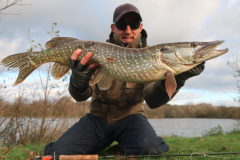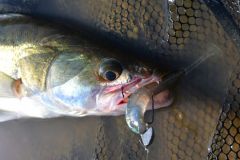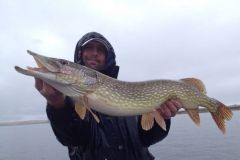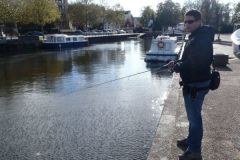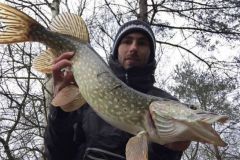Jerkbaits originate mainly from Northern Europe, where they have been widely used for pike for 3 decades. Over the past 15 years, their use has spread to France, where they have become the preferred lure for stalking predators.
Minnows and gliders
A jerkbait is a lure that comes to life with more or less sweeping, relatively dry strokes. There are two main families. Minnows jerks are fitted with a lip, generally between 10 and 13 cm for 15 to 30 g for pike, and sliders are lipless (i.e. without lip), much larger, and often with flat sides to enable them to swerve. Their size varies from 12 to 20 cm and weight from 40 to 100 g.
It's this second family that we're particularly interested in, and which is often the first step in bigbait fishing for pike.

Seasonality
While jerkbaits can be used all year round, playing on size and sound, the key seasons are spring, when pike are on the edges hunting in the spawning whitefish, and autumn.
In summer, fishing is often more difficult due to the weather, and in winter pike are sometimes deeper and more apathetic. While jerkbaits still work, other techniques are more suitable.
Conditions and scope of use
Ideal conditions for jerkbait fishing are a bottom depth of between 50 cm and 3 m, with a maximum at 5 m, good cloud cover and wind. In this low-light environment, pike are often active and jerkbaits have the particularity of making them particularly aggressive.
In brighter conditions, you'll have to adapt by playing with the characteristics of your lure or resort to gentler approaches.
I particularly like to use jerkbaits on shallow flats, above or on the edges of weedbeds, as well as on the first break where pike often lie in ambush.

Selection criteria
In addition to the animation on offer, you can play with the characteristics of the jerkbaits to suit the conditions and mood of the day.
So, while it's obviously possible to vary the size, you can opt for models designed to make pike react, i.e. with large balls and flsahy colors, or for a more discreet, natural approach with silent models in the color of the prey living in the environment you're fishing. In the same spirit, some jerkbaits will have wider, more aggressive swims, while others will be softer and tighter.
Tip
Although jerkbaits are mainly used in areas down to 4-5 m, you can fish deeper by adding an extra weight on the triple ventral or by sticking a lead pellet on your belly. Thus, by fishing more slowly, you'll be able to prospect deeper areas and decide on fish that refuse to come up.
All species
Although jerkbaits are mainly used for pike, they are also effective on most predators. It's not the most conventional and regular approach, but you'll regularly catch perch, catfish or pike-perch with this type of lure. Likewise, this lure works well on aimara, peacock bass and even some marine species.

 /
/ 





